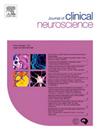Functional outcomes following endovascular treatment of vasospasm secondary to aneurysmal subarachnoid Hemorrhage: A Single center retrospective analysis
IF 1.9
4区 医学
Q3 CLINICAL NEUROLOGY
引用次数: 0
Abstract
Introduction
Endovascular treatment of post-hemorrhagic cerebral vasospasm (PHCV) has the potential to improve functional outcomes but there continues to be limited data reported in the literature.
Objective
To retrospectively review our institution’s experience treating PHCV endovascularly and report clinical outcome data.
Methods
Patients who experienced nontraumatic subarachnoid hemorrhage (SAH) and were treated with endovascular therapy were identified using ICD and CPT codes. Demographic, clinical, and outcome variables were then collected via review of electronic medical records. The primary outcome measure was rate of modified Rankin Score (mRS) ≤ 2 at discharge as well as 1, 3, and 6 months after discharge. Discharge disposition, angiographic response to treatment, and complication rates were secondary outcomes. A subgroup analysis was performed on patients treated with retrievable stents.
Results
In a 12.5 year period, 1396 patients with nontraumatic SAH were treated, and of these 82/1396 (5.9 %) were treated endovascularly for vasospasm. 200 total interventions were performed on 82 patients. 29.7 % of patients had radiographic delayed cerebral ischemia. The complication rates were 3.5 % per procedure and 4.9 % per patient. 40.7 % of patients had good neurologic outcomes (mRS ≤ 2) at any time point. In-hospital mortality was 11 % and 6-month mortality was 21 %. Higher presenting Glasgow Coma Score (GCS) predicted good neurologic outcome in univariable logistic regression (OR = 1.33, p = 0.026). Patients that underwent mechanical angioplasty were significantly younger than those who did not (46 years vs 53 years, p = 0.003). 11 cases of retrievable stent angioplasty were performed, yielding a complication rate of 9 % which was comparable to the complication rate of patients treated with balloon angioplasty (4.3 %, p = 0.54).
Conclusions
Our experience with endovascular treatment of PHCV results in similar functional outcomes and complication rates to the literature. Better presenting GCS predicts good functional outcomes in patients with PHCV treated endovascularly. Patients undergoing mechanical angioplasty tended to be younger. Retrievable stents produced similar rates of complications and good functional outcomes to balloon angioplasty patients.
动脉瘤性蛛网膜下腔出血继发血管痉挛的血管内治疗后的功能结果:单中心回顾性分析
本文章由计算机程序翻译,如有差异,请以英文原文为准。
求助全文
约1分钟内获得全文
求助全文
来源期刊

Journal of Clinical Neuroscience
医学-临床神经学
CiteScore
4.50
自引率
0.00%
发文量
402
审稿时长
40 days
期刊介绍:
This International journal, Journal of Clinical Neuroscience, publishes articles on clinical neurosurgery and neurology and the related neurosciences such as neuro-pathology, neuro-radiology, neuro-ophthalmology and neuro-physiology.
The journal has a broad International perspective, and emphasises the advances occurring in Asia, the Pacific Rim region, Europe and North America. The Journal acts as a focus for publication of major clinical and laboratory research, as well as publishing solicited manuscripts on specific subjects from experts, case reports and other information of interest to clinicians working in the clinical neurosciences.
 求助内容:
求助内容: 应助结果提醒方式:
应助结果提醒方式:


